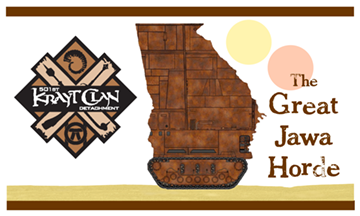Bandolier Build Guide
POST-BUILD NOTE: During the Great Jawa Build, we wanted to create a lot of Jawa costumes at a very low price point for our participants. The pleather bandoliers described here were part of that effort, but we found they were not durable: the two sides of pleather that we bonded for the straps tended to come undone, the pockets collapsed in storage, etc. At this point, we recommend that new Jawas acquire a quality leather bandolier. In particular, we recommend that rather than order something random from China (which may be acceptable, but may also be unacceptably small), order from a quality place that will size the bandolier to your particular measurements. (The Enfield bandolier is somewhat adjustable, but still designed to accommodate young, fit cavalry men from 1908. If that fits your body shape, great. But if not, expect to have to extend the straps on anything that is not custom.)
The Great Jawa Build used the basic Jawa/Tusken Bandolier pattern found here, based on a plan by Studio Creations. However there are a few things you might want to think about.
If you are thinking about using purchasing an authentic antique bandolier, that can be an attractive option (if you can find one at a reasonable price), but you should consider possible size problems. Those bandoliers were sized to fit turn-of-the-century soldiers. Modern Americans tend to be a bit bigger. If you're not trying to outfit a child or a relatively small adult, authentic bandoliers will tend to be on the small side and may require an extension strap of some kind. If you have to match the original leather, such a strap might be hard to come by.
The pattern in the link above is designed to match the size of the original 1908 Enfield bandolier. For the Great Jawa Build, we modified the basic pattern in the link above to add 6 inches to each of the bandolier straps. This modification was enough to make the bandoliers fit many folks (using the range of size adjustment that the basic pattern allows). We did make some bandoliers in the original size, but those were mostly useful for children. And we made some 12" extension straps that were useful for exceptionally large Jawas.
Some other notes:
- We used Marine Vinyl Fabric (pleather) sourced from Joann Fabric.
- We were also lucky enough to have someone, TD 24122, who was willing to use a laser cutter to cut out the individual pockets. This was a huge time saver and was really what allowed us to make bandoliers at scale.
- For the bandolier straps, we thought that a single thickness of pleather was too thin, so we doubled up. We cut the pleather into 2'x4' segments and bonded pairs of segments back-to-back using a spray contact adhesive. (You might be better off using WonderUnder, but the spray adhesive was quicker.) (LATER NOTE: The spray adhesive has not held up well with time. That is, the double thickness of pleather on our bandoliers has tended to come undone, particularly for our later bandoliers. This might be a function of the contact adhesive we used, how heavily it was applied, the temperature and humidity when it was applied, or something. Just be aware that you might have to try alternatives.)
- In order to make many bandoliers, we converted the bandolier strap patterns into wooden forms, then cut around those forms using rotary fabric cutters.
- You're going to need hardware. We used these:
- Tandy Leather Rapid Rivets Small Antique Brass Plated . You'll need at least 27 per bandolier, and more if you mess up, so buy extra.
- Bronze "Sam Browne" buttons. You might find these under a variety of names, including "Brass studs" and "head buttons". Need 5 per bandolier.
- Antique brass Buckles, either 1" or 1 1/4", one per bandolier. After looking at a lot of sources, we found the most economical approach was to buy a set of 5 buckles here, and only use the largest.
- Antique brass D-rings, one per bandlier. We used these, but lots of sources.
The pattern PDF is a bit vague about how you finalize the bandolier, I.E. how you attach one end to the other. The actual connection is somewhat complex, but it uses all the holes and allows size adjustments, so don't just attach the buckle to the end of the bandolier without knowing how it's supposed to work! (Pics coming soon.)
We didn't bother making the "sling strap" that dangles from the bandolier and is designed to loop around an actual belt to keep the bandolier in place.
DZ-61970

